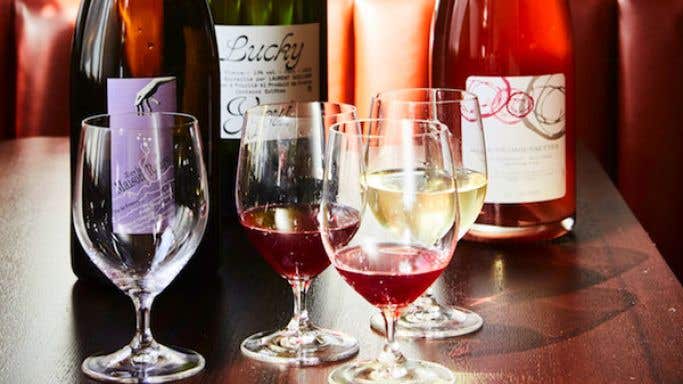The restaurant everyone in New York is talking about has a fatal flaw.
A version of this article is published by the Financial Times. The image is part of the main one on Frenchette's website.
I was sitting opposite the daughter of a successful New York restaurateur. Well, not quite, because between us there was her laptop, which was full of figures for the café that she plans to open in the summer of 2019 that will focus on selling her own ice cream.
She sighed, looked up and asked me, ‘How does a restaurateur make money, Nick?’ ‘By maximising the sales of alcohol', was my immediate response. ‘I thought so', she replied despondently and went back to trying to make her figures add up.
I thought of this maxim of the restaurant trade after my second meal at Frenchette, a much-discussed restaurant that opened in Tribeca, New York, a few months ago.
The food is very good. The determinedly ‘French bistro’ setting could not have been more thoughtfully created. The acoustics could certainly be better, but it is rumoured that this aspect is a work in progress. But they have decided to offer a wine list of exclusively natural wines. Described as a ‘brave decision’ by some, this has irritated other diners.
The restaurant starts with several advantages. The building it occupies used to be another French restaurant, Le Cercle Rouge, so it has the right feel. It has a simple, truly memorable name – borrowed from a 1978 song written by David Johansen – that fits the culinary ambitions of the chefs involved. And right next door is Bâtard, Drew Nieporent’s long-running high-end restaurant.

Frenchette marks the reappearance in this city of two chefs, Riad Nasr and Lee Hanson, who since 1997 have cooked together to satisfy New Yorker’s hunger for French food. They were brought together by restaurateur Keith McNally, initially at Balthazar then most recently at Minetta Tavern. This is their first independent venture and the space that has been designed for them could not be of a higher quality.
This is obvious from the moment you push through the heavy front door and find yourself in a wooden vestibule. The quality of the wood is noticeable, a design trait that is carried on throughout the bar area and then into the restaurant behind. The dark-brown wood panelling forms an intriguing arch into the open kitchen that faces the customer and then is replicated over the two arches opposite. Mirrors, clever lighting, large displays of autumnal flowers and brown leather banquettes set an exciting, vaguely Parisian stage.
This same confidence is carried over into the design of the menu. The name of the restaurant appears in the top left hand corner in a light green font with a clear line, in the same colour, dividing the dinner menu into amuses and garnitures on the left and hors d’oeuvres and entrées on the right-hand side, and, on the lunchtime menu, the line divides a two-course menu roquette ($28) and a three-course menu amusette ($38) from the hors d’oeuvres and entrées.
All of this offers enough choice for the adventurous and the less adventurous eater. Dinner excited four of us – from a well-judged dish of raw tuna with endive and apple to a more challenging combination of veal tongue, soft and slightly fatty, with the acidic addition of three pieces of grilled mackerel and some well-dressed salad leaves.
The main course choices are even wider. One of us was extremely happy with her choice of ‘duck frites’, a grilled duck breast hiding under a mound of French fries that was to happily satisfy her husband too. My dish of veal kidneys with mustard was well executed with the kidneys absorbing the mushrooms and the cream sauce, all of which was fodder for the pasta underneath. The only criticism of their pithivier, stuffed full of wood pigeon and foie gras, was the absence of a small amount of refreshing salad leaves on the side.

I happily returned for lunch a couple of days later and was intrigued by their $38 menu amusette that included, inter alia, skate wings and a slice of tarte Tropézienne, the ultra-sweet dessert created in St-Tropez in 1956 by pâtissier Alexandre Micka. I began with tripe in a tomato sauce followed by a far healthier dish, a version of a pan bagnat of tuna with an artichoke bottom taking the place of the bread normally used as a base. The slices of tuna were thick and delicious, as was a shared Paris-Brest dessert filled with pistachio cream.
Disappointment came only with the all-natural wines, those made without preservatives or processing aids and where intervention is kept to a minimum. This is the creation of sommelier Jorge Riera, and his hardline policy – he refused to let a wine-loving friend open a couple of bottles of top-quality French wine and pay corkage – will not endear him to the locals.
Given its uncompromising nature, the wine list could be a lot more helpfully descriptive, especially since so many wines qualify merely as Vin de France so the diner has no clue where they come from nor which grapes they might be made from. As we asked for a bottle of Tavel 2016 from cult producer L’Anglore, the waitress had to lean across the table to ask my wife to point to the bottle to be sure she understood correctly.
With today’s rents and two head chefs’ salaries to pay, Frenchette’s future may depend on increasing the volume of wine sales.
Frenchette 241 W Broadway, New York 10013; tel +1 212 334 3883

